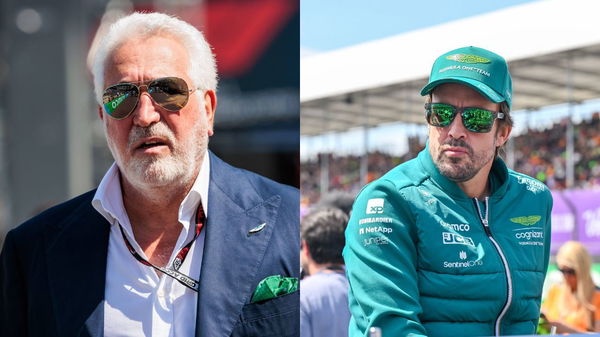
via Imago
L-R: Lawrence Stroll, Fernando Alonso Image Courtesy: Imago

via Imago
L-R: Lawrence Stroll, Fernando Alonso Image Courtesy: Imago
The FIA flexi wing saga started in 2021. Before we get to that, what is a flexi wing, you ask? They’re aerodynamic components, specifically the front and rear wings on the car, that generate downforce. When Formula 1 cars go at the speeds they do, their front and rear wings naturally oscillate slightly. But in 2021, certain teams appeared to exploit the flexibility of the wing elements to gain an advantage, and that’s where the whole flexi wing controversy started. This season, it was Fernando Alonso and Aston Martin’s front wing that came into question.
While the FIA paid closer attention to the rear wings in 2021, its focus has been on the construction of front wings this season. When the season started, Red Bull stated its claim as the team to beat, but to everyone’s surprise, Aston Martin was right behind the Milton-Keynes outfit. Seeing as how Aston Martin finished P7 last season, its sudden resurgence raised eyebrows, and it looked like its flexi front wing might’ve something to do with it.
ADVERTISEMENT
Article continues below this ad
Fernando Alonso & Co.’s second-half resurgence might be in danger
After starting the season in top form—primarily due to the $300 million investment, Aston Martin owner Lawrence Stroll made for a new factory—Alonso and Aston’s form started to dip after the Canadian GP. Until then, there seemed to be onboard footage of Alonso’s car that showed a significant flex in the front wing as the AMR23 hit top speed in the straights, reducing drag and giving it an advantage.
#F1: Teams will face a fresh clampdown on flexi wings after the Italian Grand Prix, with the FIA issuing a TD to ban tricks it believes are illegal. 🚨
The FIA has been taking a close look at flexible wings over the first half of this season as it believes teams have been…
— deni (@fiagirly) August 30, 2023
Sometime around the Azerbaijan GP, a few races before Canada, the FIA informally advised some teams to make changes to these flexi wings to avoid any trouble in the future. It seems as though—despite Aston’s new front wing concept—they didn’t make too many changes because the FIA has had to step in with a formal Technical Directive (TD). This has come at a time when Aston Martin was just getting back the form it lost in the first half. As F1 returned after the summer break, Alonso showed a stellar performance at the Dutch GP, qualifying P5 and finishing P2.
But as Alonso made his scintillating return to form (which could’ve been because of Aston Martin’s flexible front wing), the FIA returned to rain on Aston’s parade. As reported by Motorsport.com, “In TD018, the FIA states that it believes outfits are exploiting ‘regions of purposely design localized compliance’ plus ‘relative motion between adjacent components’ to deliver a significant boost to aerodynamic performance.”
Read More: Fernando Alonso & Co. Take Advantage of Groundwork Laid Down by Alpine by Last Minute Poaching
Furthermore, “It states that any design that operates like this is in breach of Article 3.2.2 of F1’s Technical Regulations, which states that all components that influence a car’s aerodynamic performance must be ‘rigidly secured and immobile with respect to their frame of reference’ defined in Article 3.3.” Evidently, Aston Martin’s $150,000 front wing didn’t comply with these rules. Despite the disadvantage that’s coming its way after the Italian GP, Aston Martin may still have an advantage over its chief rival.
Alonso has a “sweet spot” advantage over Lewis Hamilton
After a dip in performance after the Canadian GP, Aston Martin and Alonso regained the momentum they lost in the first half. When Aston dropped off, Lewis Hamilton & Co. at Mercedes picked up its pace and made significant gains on Alonso’s AMR23. Going into the summer break on a positive note, Mercedes would’ve wanted to continue building the gap to Aston. While the Asturian came back with a bang to finish second in Zandvoort, Mercedes had a nightmare of a race.
ADVERTISEMENT
Article continues below this ad
We gave it our all on the track. Very happy with the pace of the car, the podium, the fastest lap, and the strategy. Thank you @AstonMartinF1 💚, what a Sunday . #f1 #astonmartin #zandvoort pic.twitter.com/Q9ZNWBlhq0
— Fernando Alonso (@alo_oficial) August 27, 2023
Although this could’ve been just a one-off occurrence, F1 journalist Peter Windsor revealed Aston’s advantage over Mercedes. In a YouTube livestream after the Dutch GP, Windsor said, “I think the Aston Martin, right now, probably doesn’t have as much efficient downforce as the Mercedes when the Mercedes is right. But [Aston Martin] has a much bigger sweet spot around which the drivers and the engineers can work. That’s what we saw at Zandvoort.”
ADVERTISEMENT
Article continues below this ad
Watch This Story: “They Know More About Our Car Than We Do”: Mercedes’ Spooky Radio Message to Lewis Hamilton Left Fernando Alonso & Co. Shell Shocked
Do you think Fernando Alonso can keep up the momentum, or will the FIA’s new Technical Directive affect Lawrence Stroll & Co. more than they expect?
ADVERTISEMENT
ADVERTISEMENT
ADVERTISEMENT
ADVERTISEMENT
